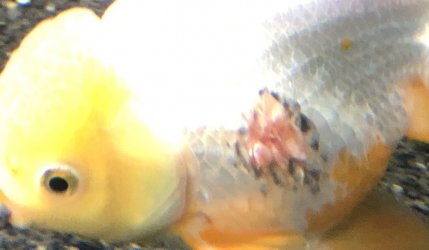At the moment I am using tri-sulfa in the water and melafix. Should I continue with that until I find some food? I do have some aquaricycline otherwise?
Don't use triple/ tri sulpha, melafix or any other fish medication on this because it won't work. You need anti-biotics, which the vet has prescribed.
Yes, medicated food contains an anti-biotic. They normally have a pellet which is laced with anti-biotics and that is fed to the fish several times per day for about 2 weeks. Some are only used for 1 week and then no medicated food for a week, followed by a second course. This is because most anti-biotics cause kidney damage and long term use can kill fish. But follow the vets instructions for the medication they gave you to use.
You can add it to dry or frozen food. If using frozen food, put the food in a fine mesh net and hang it in a bucket to let most of the water drain off. Then put the frozen but drained food into a small bowl and add the anti-biotics. Mix well and feed to the fish.
After handling the anti-biotics/ food, pour some boiling water over the bowl and any remaining food, and let it sit for a couple of minutes before washing with hot soapy water. The heat will break down the anti-biotics and there will be less chance of bacteria in the drains finding the anti-biotic residue and potentially developing a resistance to it. And wash your hands well with warm soapy water after feeding the fish or working in the tanks.
If you have any cuts or scratches on your hands or arms, do not put them in the tank or let tank water get onto the damaged skin.
---------------------
Dirty water and stress from shipping may have contributed to this but the fish had the problem before it was sent to you.
The fish is white and has a red sore on the side of its body. Whoever caught it and packed it to send to you is either blind or has no idea about fish. But any white fish with a red spot on the side, even a small red spot, should have been checked to make sure it wasn't a wound, sore or ulcer. They obviously didn't do that.
---------------------
How much salt did you add to the tank?
You need to add 1 heaped tablespoon of rock salt, sea salt or swimming pool salt for every 20 litres of tank water.
You will need to keep this salt level for about 1 month.
To work out the volume of water:
measure length x width x height in cm.
divide by 1000.
= volume in litres.
When you measure the height, measure from the top of the gravel to the top of the water level.
If you have external filters, add their water to the tank's water volume.
Make sure you remove any carbon from filter before adding any medication to the water.
Wipe down the inside of the glass, gravel clean the tank, and do a big water change (75%) before treating fish. This removes a lot of the harmful pathogens in the water and allows medications to work more effectively. This should be done for any fish health issue.
Make sure any new water is free of chlorine/ chloramine before it is added to the aquarium.
When adding salt during water changes, only add enough salt for the water you are adding.
eg: you replace 40 litres of water so you add 2 heaped tablespoons of salt to that 40 litres of water.


